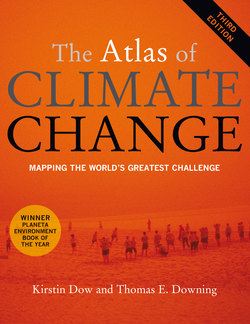Читать книгу The Atlas of Climate Change - Professor Kirstin Dow - Страница 24
На сайте Литреса книга снята с продажи.
ОглавлениеThe permafrost around the Arctic is generally warming. In some areas, it is making a weakened coastline more prone to erosion, and causing subsidence, leading to the collapse of roads and buildings. It is also creating lakes of trapped melt water, which may increase carbon dioxide and methane emissions. Each summer, parts of the Greenland ice sheet melt at the edges and on the surface. Although the melt area varies each year, the overall trend since 1979 has been upwards. Surface melt water finds its way through crevasses to the base of the ice, and forms a thin film between ice and bedrock. There are fears that this could increase the speed at which the ice sheet slides towards the sea.
36–37 The Climate System; 42–43 Climate & Social Crises
25
